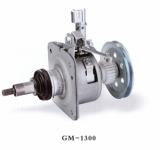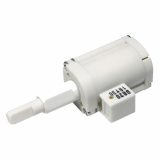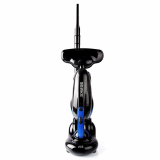Although the mechanism of atomization of a liquid jet atomization of high-speed liquid jets with a wide range of applications in engineering , but people understand the details of the atomization process and mechanism of the low-speed jet Queyuanburu crushing separatist know so deep . So far, several have been proposed to explain about the atomization mechanism , but none of which can be entirely convincing and subjected to experimental testing.
( 1 ) said aerodynamic interference aerodynamic interference say is more recognized as a hypothesis about the mechanism of atomization , it low to the high-speed jet breakup theory jet promotion. Castleman in 1932 proposed the aerodynamic interference , said he believes that due to the aerodynamic interference between the jet and the surrounding gas , the jet surface fluctuations unstable. As the speed increases speed , nozzle unstable wavelength waves are getting shorter, so the jet spread into a mist . There are also some researchers using linear perturbation analysis, starting from the analysis of the stability of axisymmetric small perturbations on the jet surface waves , ignoring the gas viscosity, and is assumed to be described by a variety of gas and liquid velocity and pressure perturbation N-S linearized equations , solving equations introducing the stream function , and ultimately get the contact rate and wavelength of the wave function of the relationship . Ranz et al based on Taylor 's theory of fluid stability that the droplet size depends on the wavelength of the most unstable wave , and an expression derived spray cone angle . Reitz and Bracco , who summarized the previous research on two-dimensional axisymmetric unstable linear perturbation theory , put forward a unified theory of first-order linear Breakup of liquid derived dimensionless dispersion equation , the numerical solution of fitting out the fastest growing unstable wavelength and frequency of the wave equation .
( 2 ) said in a study of the turbulent perturbation pressure atomized spray in the past have shown that the jet spray characteristics affected by the exit of turbulence. Dejuhasz et al jet nozzle atomization process occurs in the interior , and the turbulence of the liquid itself may play an important role. Lee atomization pressure study showed that the rate of mixing and atomization quality with both the outlet of the jet flow is laminar or turbulent change . Schweitzer considered , for turbulent pipe flow radially inner nozzle movement speed of the nozzle causes the liquid at the nozzle outlet immediately disturbed , resulting in atomization. Grant, Phinney observed jet stability and fragmentation occurs equally affected by the exit of the jet turbulence . They believe the turbulence generated in the flow channel features a large impact on the jet breaking even relatively short orifice also shows the disturbance caused by turbulence flow reattachment point after separation zone generated .
Although the mechanism of atomization of a liquid jet atomization of high-speed liquid jets with a wide range of applications in engineering , but people understand the details of the atomization process and mechanism of the low-speed jet Queyuanburu crushing separatist know so deep . So far, several have been proposed to explain about the atomization mechanism , but none of which can be entirely convincing and subjected to experimental testing.
( 1 ) said aerodynamic interference aerodynamic interference say is more recognized as a hypothesis about the mechanism of atomization , it low to the high-speed jet breakup theory jet promotion. Castleman in 1932 proposed the aerodynamic interference , said he believes that due to the aerodynamic interference between the jet and the surrounding gas , the jet surface fluctuations unstable. As the speed increases speed , nozzle unstable wavelength waves are getting shorter, so the jet spread into a mist . There are also some researchers using linear perturbation analysis, starting from the analysis of the stability of axisymmetric small perturbations on the jet surface waves , ignoring the gas viscosity, and is assumed to be described by a variety of gas and liquid velocity and pressure perturbation N-S linearized equations , solving equations introducing the stream function , and ultimately get the contact rate and wavelength of the wave function of the relationship . Ranz et al based on Taylor 's theory of fluid stability that the droplet size depends on the wavelength of the most unstable wave , and an expression derived spray cone angle . Reitz and Bracco , who summarized the previous research on two-dimensional axisymmetric unstable linear perturbation theory , put forward a unified theory of first-order linear Breakup of liquid derived dimensionless dispersion equation , the numerical solution of fitting out the fastest growing unstable wavelength and frequency of the wave equation .
( 2 ) said in a study of the turbulent perturbation pressure atomized spray in the past have shown that the jet spray characteristics affected by the exit of turbulence. Dejuhasz et al jet nozzle atomization process occurs in the interior , and the turbulence of the liquid itself may play an important role. Lee atomization pressure study showed that the rate of mixing and atomization quality with both the outlet of the jet flow is laminar or turbulent change . Schweitzer considered , for turbulent pipe flow radially inner nozzle movement speed of the nozzle causes the liquid at the nozzle outlet immediately disturbed , resulting in atomization. Grant, Phinney observed jet stability and fragmentation occurs equally affected by the exit of the jet turbulence . They believe the turbulence generated in the flow channel features a large impact on the jet breaking even relatively short orifice also shows the disturbance caused by turbulence flow reattachment point after separation zone generated .
 China
/
China
/

 Australia
Australia
 India
India
 Pakistan
Pakistan
 Philippines
Philippines
 South Korea
South Korea
 U.S.A
U.S.A







































